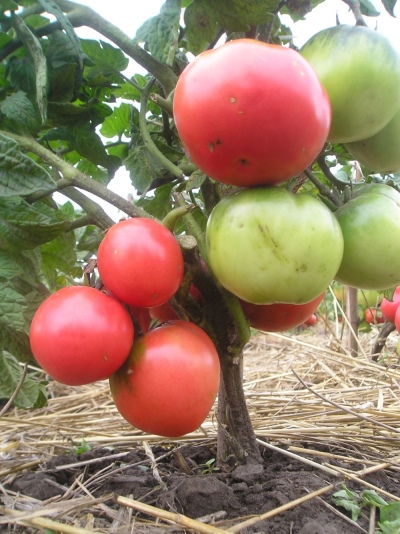
- Authors: Lukyanenko A.N., Dubinin S.V., Dubinina I.N.
- Year of approval: 2008
- Category: grade
- Growth type: determinant
- Appointment: fresh consumption
- Ripening period: ultra early
- Ripening time, days: 85-90
- Growing conditions: for open ground, for film greenhouses
- Bush height, cm: 40-50
- Bush characteristic: compact
Tomatoes, bred in the 2000s, are already becoming an everyday attribute of many vegetable gardens. But it is very important all the same to exclude errors in their cultivation and planting. Only in this case will the Pink Leader variety show its best qualities.
Breeding history
Officially, this crop has been allowed for cultivation in consumer gardens since 2008. It should be emphasized that it really is a variety (and not a hybrid) in the botanical sense. The work on the project was carried out by breeders Lukyanenko and Dubinin.
Description of the variety
The bushes of the Pink Leader will develop in a determinant pattern. They can be planted both in open ground and in greenhouses under a film. Plant height does not exceed 40 or 50 cm. Compact tomatoes are covered with large green foliage. For them, the formation of a trunk is typical.
The main qualities of the fruit
At the time of formation, the fruits are light green in color. Later, having gained ripeness, they acquire a pink color corresponding to the name of the variety. The berries are large in size and weigh 120-150 g. For them, a typical flat-round configuration with weakly pronounced ribs. The crop will develop on simple inflorescences, its stalks are articulated.
Taste characteristics
The harvested crop is mainly consumed fresh.
Ripening and fruiting
Tomato Pink Leader belongs to the ultra-early varieties. He is able to develop a harvest from young seedlings in 85-90 days. However, the result is often influenced by the weather. It will also be necessary to take into account the impact of agrotechnical work.
Yield
One Pink Leader plant can produce 3 or 4 kg of berries. Fee per 1 sq. m in open ground is up to 10 kg. In a greenhouse, it can be 2 kg more. However, here we must not forget about the growing conditions and the applied care measures.
The timing of planting seedlings and planting in the ground
Seedless cultivation of this variety is almost impossible in most of Russia. Even where there is a potential risk, it is not wise to do so. Sowing seeds in containers is usually done at the end of March or in the first decade of April. The choice of a particular option depends on the weather and other nuances.

Growing tomato seedlings is an extremely important process, because it largely depends on whether the gardener will be able to harvest at all. All aspects must be taken into account, from seedbed preparation to planting in the ground.
Landing scheme
In the official description of the variety, it is not disclosed in any way. Third-party sources indicate that it is necessary to adhere to the 500x400 mm system. Up to 8 Rose Leader bushes can be planted per m2.

Growing and care
There is usually no need to remove stepchildren. It occurs only if the bushes are overgrown and thickened. It is believed that the variety is good against late blight and negative weather. However, it is better to play it safe and provide protection measures against these factors. The site should be well lit, but at the same time perfectly protected from the effects of the wind.
You need nutritious and loose soil with a good level of drainage. Before planting a tomato, the territory will have to be dug up and loosened. This variety has no special requirements for cultivation. But you still have to:
make mineral complexes according to the general schedule;
loosen the ground after each watering;
systematically weed the beds;
track soil moisture (both waterlogging and dryness are equally bad).




A plant needs different micronutrients at each stage of growth. All fertilizers can be divided into two groups: mineral and organic. Folk remedies are often used: iodine, yeast, bird droppings, eggshells.
It is important to observe the rate and period of feeding. This also applies to folk remedies and organic fertilizers.


Growing regions
The planting material supplier promises that it can be used:
in the North Caucasus;
in Siberian, Ural and Far Eastern vegetable gardens;
in the Black Earth Region;
in the European part of Russia;
in the Volga region and the Volga-Vyatka region.
Review overview
The pink leader is also among the leaders according to the estimates of the farmers themselves. It can be grown successfully for many years without disappointment. Both the appearance and the gastronomic performance will be at a very high level. There is no reason to complain about productivity either.

























































































